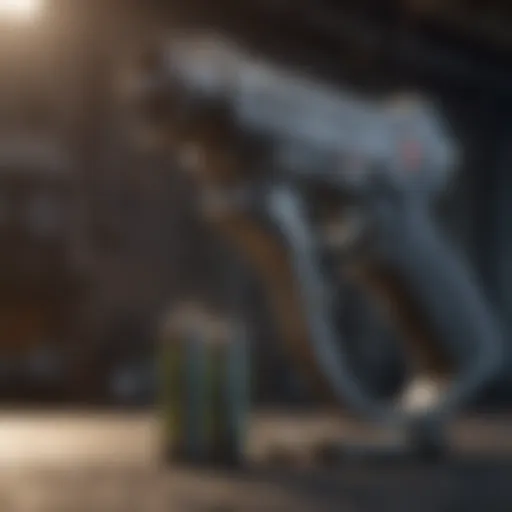Exploring Water Based Polycrylic Spray: A Comprehensive Guide
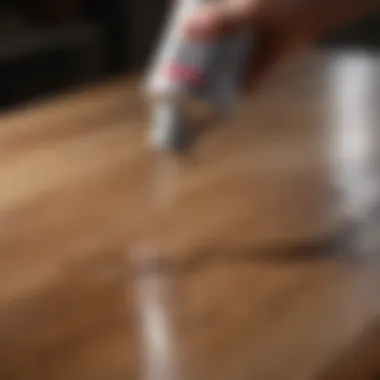

Intro
Water-based polycrylic spray has become a popular choice among homeowners and project enthusiasts alike, transforming how we approach finishing and protecting various surfaces. This clear coating provides an elegant finish while being notably more friendly to the environment than traditional oil-based options. The versatility of this product makes it suitable for wood, metal, and even some types of plastic, ensuring that it meets the diverse needs of various DIY projects.
In today’s world, numerous factors push us towards eco-conscious choices. Water-based polycrylic not only minimizes harmful emissions but also simplifies clean-up—just soap and water will do! Understanding these attributes positions homeowners to make informed decisions, ultimately saving them time and money while achieving admirable results.
This guide provides an in-depth look at water-based polycrylic spray, exploring its unique characteristics, practical applications, and the various benefits it brings to any home improvement project. With easy-to-follow techniques, potential hurdles, and product recommendations, one can navigate the complexities of using this spray without feeling overwhelmed. Ultimately, the goal is to inform you so you can confidently enjoy the results of your hard work and creativity.
Prelude to Water Based Polycrylic Spray
When talking about finishing materials for interior or exterior projects, water based polycrylic spray deserves a good bit of attention. This isn't just another fancy term tossed around in DIY circles; it signifies a revolutionary shift in how homeowners tackle their finishing needs. The boom in home improvement projects has spotlighted the importance of versatile substances that promise not just quality but also ease of use and safety.
A key element of considering water based polycrylic spray is its environmental angle. Homeowners today are more aware of the impacts their projects have on the surroundings. With its non-toxic and low VOC (Volatile Organic Compounds) properties, this material stands out as a responsible choice among finishes. While oil-based products have a history of durability, the modern demands of sustainability lend favor to water based options. This switch is not just about being trendy; it's about being wise in choosing what we use in our homes.
Definition of Water Based Polycrylic
At its core, water based polycrylic is a clear, durable finish that combines the convenience of a spray application with water as its primary solvent. Unlike traditional oil-based polyurethanes, this finish dries quickly and permits the use of water for cleanup. Because of its formulation, it combines the best traits of various finishes. You get strength akin to varnishes while enjoying a user-friendly application – perfect for anyone who's not a seasoned expert.
Furthermore, it serves a dual purpose: it protects surface materials like wood from scratches, stains, and moisture exposure while enhancing the visual appeal of the natural grain. You might have seen it on furniture projects or used on cabinetry, and perhaps you've even wondered what gives the surface that beautiful sheen.
Historical Context and Development
The evolution of water based finishes is intriguing, rooted in the increasing focus on health and environmental standards from the late 20th century onward. Initially, oil-based products dominated the market, but as time wore on, the industry began recognizing the issues that came along with those products, particularly their toxicity and longer drying times.
Water based options began to appear in various forms throughout the 1980s, but they weren't without their challenges. Many earlier iterations lacked durability and left users unsatisfied. The demand for a reliable and safe solution led to continuous innovations in chemical formulations.
By the early 2000s, advancements in technology resulted in formulations that offered both strength and ease of use. Nowadays, water based polycrylics boast improved adhesion and flexibility, making them suitable for a myriad of projects – from simple touch-ups to elaborate home renovations.
As these products gained traction, the growing awareness of environmental responsibility among manufacturers brought a wave of consumer choice. Today, water based polycrylic spray stands as a notable option for both professional contractors and passionate DIYers alike.
In summary, understanding water based polycrylic spray is crucial in navigating today’s painting and finishing landscape. By concentrating on its advantages, historical context, and definition, readers can appreciate the light it sheds on modern-day projects and how it fits into their personal or professional endeavors.
Composition and Properties
Understanding the composition and properties of water based polycrylic spray is crucial for anyone looking to achieve a professional finish in their projects, whether that’s a simple craft, refinishing furniture, or enhancing cabinetry. The intrinsic qualities shape not only how the product performs during application but also how it holds up over time. Grasping these components helps in making informed decisions tailored to the specific needs of the project at hand.
Chemical Makeup
Water based polycrylic spray is typically composed of a blend of acrylic resins and water, making it a strong contender for those seeking a more eco-friendly alternative to oil-based products. Unlike traditional finishes, which can contain high levels of volatile organic compounds (VOCs), the water-based variety boasts significantly lower emissions. Thus, it’s kinder to the environment and safer for indoor use.
Key components include:
- Acrylic Polymers: These are the backbone of the finish, providing durability and gloss.
- Water: Used as the primary solvent, making it easy to clean up with just soap and water.
- Additives: Certain additives enhance properties like drying time and flow, ensuring a smooth application.
By using such a formulation, you can achieve a clear, non-yellowing finish that maintains its beauty over time.
Physical Characteristics
When it comes to physical attributes, water based polycrylic spray has a unique profile. It is generally milky in appearance, transforming into a clear coat upon drying, which many find appealing. This transformation ensures the underlying surface retains its natural color or stain without any unsightly yellowing that can mar the finish of projects over time.
Notable physical characteristics:
- Viscosity: A lower viscosity compared to oil-based options facilitates easier application and lessened risk of runs or drips.
- Drying Time: It boasts a relatively short drying time, typically about 30 minutes to touch dry, which allows for quicker project turnaround.
- Sheen Variations: Available in multiple sheen options—from matte to high-gloss—allowing for personalized finishes.
These qualities make it an attractive choice, especially for intricate projects that require precision and a delicate touch.
Durability and Resistance
One of the standout features of water based polycrylic spray is its durability. Its formulation renders it highly resistant to scratches and moisture, making it suitable for a variety of applications ranging from kitchen cabinets to bathroom vanities.
Consider these durability factors:
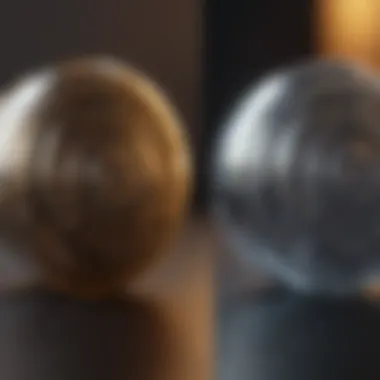

- Scratch Resistance: Once cured, it holds up remarkably well against everyday wear and tear.
- Moisture Resistance: This is particularly important in humid environments. The finish helps protect the wood or other surfaces without degrading.
- Stain Resistance: Spills from food or beverages can often be wiped away without leaving marks, especially if the finish is well-cured.
"Opting for water based polycrylic means investing not only in a product that cares for the environment but also one that provides exceptional endurance in a variety of conditions."
In summary, the combination of its chemical makeup, physical characteristics, and impressive durability articulates why water based polycrylic spray stands out as a reliable finish. Understanding these elements helps in maximizing its potential in your projects, ensuring your efforts yield lasting beauty and functionality.
Applications in Various Projects
Understanding the applications of water based polycrylic spray is crucial for both professional artisans and enthusiastic DIYers. This versatile product goes beyond mere aesthetic enhancement; it provides a protective layer that prolongs the life of various surfaces. The adaptability of polycrylic makes it a prime choice for diverse projects, ensuring that wood finishes shine, artistic expressions flourish, and crafts stand the test of time.
Wood Finishes
Furniture
When it comes to furniture, water based polycrylic spray is celebrated for its ability to showcase natural wood grain while offering a tough, protective finish. This dual advantage makes it a popular choice for both new and refurbished pieces. One key characteristic of polycrylic is its quick-drying formula, which aids in faster turnaround times—perfect for those who want to see immediate results. Additionally, the non-yellowing properties ensure that colors remain vibrant over time.
The unique feature of polycrylic is its water-based formulation, which makes cleanup a breeze compared to oil-based alternatives. However, it’s important to note that under extreme wear and tear, it might need periodic reapplication, especially on high-traffic surfaces.
Cabinetry
In cabinetry, water based polycrylic spray shines for its ability to provide a smooth, even finish without the fuss of traditional methods. The key characteristic here is the versatility of application; whether it's a sleek, modern kitchen or a rustic sideboard, polycrylic adapts seamlessly. Cabinetry often faces challenges like humidity and temperature fluctuations, and polycrylic resists such stressors, making it a durable option.
Another unique feature is its low odor and safety during application, catering to environments where fumes could be a concern, such as inside homes. Yet caution should be exercised during application; if not applied correctly, it might lead to uneven coats that could mar the finished look.
Artistic Uses
Canvas
When diving into artistic applications, water based polycrylic spray serves as a protective armor for canvas artworks. Its non-yellowing characteristics highlight vibrant colors, allowing artists to encapsulate their creations without fear of fading over time. This protective layer prevents dirt and moisture from deteriorating the piece, making it an ideal companion for artworks meant for prolonged exposure, like gallery pieces.
The ease of spray application means artists can achieve a seamless finish without compromising the depth of their work. Nevertheless, it’s crucial to test on a sample canvas, as certain mediums may interact unexpectedly with the spray, leading to challenges if precautions aren’t taken.
Mixed Media
In the realm of mixed media, where various materials converge, polycrylic spray becomes an ally for artists aiming to unify textures and finishes. This product allows for an odd blend of items—from paper to fabric to wood—to coexist under a common protective finish. Its distinctive ability to bond with multiple surfaces means that the integrity of the artwork remains intact.
While its adaptability is a considerable advantage, keep in mind that mixed media pieces may require special attention, particularly when layering. For example, not all adhesives used in mixed media will interface well with polycrylic, potentially compromising the overall durability of the work.
Crafts and DIY Projects
Craft enthusiasts will find that water based polycrylic spray is fundamental in enhancing and protecting diverse projects. Whether you’re working on home decor items, handmade gifts, or seasonal crafts, this spray ensures that everything from wooden ornaments to painted rocks benefits from its durability and aesthetic appeal. Its fast-drying time means you can quickly complete a project without lengthy waiting periods.
Consider using polycrylic if your crafts will be subjected to handling or display in high-traffic areas. It provides the necessary shield against wear, allowing your creative efforts to be enjoyed for years to come.
"Water based polycrylic spray is not just a finish; it’s a partner in your creative journey, adding longevity and beauty to your projects."
By understanding the various applications of polycrylic spray, you empower your creativity and elevate the quality of the projects you undertake. Whether it's furniture, artistic pursuits, or DIY crafts, this product brings a renaissance to the way we protect and present our work.
Benefits of Water Based Polycrylic Spray
Understanding the benefits of water based polycrylic spray goes beyond just knowing that it’s a valuable tool in the arsenal for home improvement and crafting. It serves multiple purposes, offering an array of advantages that appeal to both seasoned professionals and weekend warriors alike. The following sub-sections will delve into the various important elements that make this product stand out—its quick drying time, resistance to yellowing, and its environmental considerations.
Quick Drying Time
One of the standout features of water based polycrylic spray is its remarkably quick drying time. When tackling any painting or finishing project, a prolonged drying period can be a real buzzkill, particularly if there are time constraints or deadlines. With this spray, users can typically expect the surface to dry to the touch in about 30 minutes. This means that you can apply multiple coats in a matter of hours rather than days, which is a blessing when your to-do list is higher than a kite.
Additionally, this attribute plays nicely into its usability for urgent repairs or last-minute touch-ups. It's perfect for those who don’t want to wait around and would rather spend their time enjoying the results of their handiwork. Just imagine: you start your project in the morning and by evening, you’re admiring your newly finished cabinets or masterpiece without considering the risk of smearing or messing up some hard work.
Non-Yellowing Properties
Another gem in the crown of water based polycrylic is its non-yellowing properties. Unlike some oil-based finishes that may develop a yellow tinge over time, this spray retains its clarity and brightness. This characteristic not only enhances the aesthetic appeal of your projects but also guarantees that colors remain true to form.
For instance, if you meticulously crafted a vibrant piece of art or purchased striking paint for your furniture, a non-yellowing finish ensures that your hard work stays radiant and doesn’t take a turn for the worse as it ages. No one wants to watch their beautiful projects fade into a dull pigment, after all. This advantage makes it particularly beneficial for maintaining the integrity of lighter colors or intricate designs in artistic works.
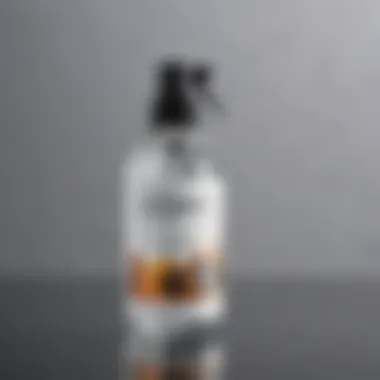

Environmental Considerations
When it comes to eco-friendliness, water based polycrylic spray wins hands down. It stands out as a more sustainable choice in a landscape where environmental impact is a topic of increasing importance. Unlike many traditional finishes, which may emit harmful volatile organic compounds (VOCs), this spray contains considerably fewer VOCs. This poses less of a health risk for those using it, especially in enclosed spaces without proper ventilation.
Moreover, being water-based means cleanup is a breeze. You won’t need to invest in expensive solvents just to clean your brushes or sprayers—instead, soap and water will do. This not only saves time and money but also reduces the environmental footprint associated with the cleanup process.
Using water based polycrylic spray is a step towards a greener, more sustainable approach without compromising on quality or efficiency.
In essence, opting for water based polycrylic spray means embracing benefits that resonate with both practicality and sustainability. It simplifies projects by ensuring quick application, maintains the beauty of your designs, and puts a lesser strain on the environment. As you embark on your next project, weighing these advantages could very well lead you to making a decision that aligns with both your values and your aesthetic aspirations.
Application Techniques
When it comes to using water based polycrylic spray, mastering application techniques makes all the difference in achieving that flawless finish. The effectiveness of this product hinges not only on its inherent qualities but also on how well it's applied. Employing the right techniques allows you to get the best results, enhancing both the durability and aesthetic appeal of your projects.
Surface Preparation
Before applying polycrylic, surface preparation is paramount. No matter how high-quality your spray is, it won't adhere well to a messy or poorly prepped surface. Start by cleaning the surface thoroughly. Dust, dirt, and grease can wreak havoc on the finish. For wooden surfaces, sanding is essential—this creates a smooth texture and helps the polycrylic bond effectively. Use a fine-grit sandpaper and sand in the direction of the grain to avoid scratching the wood.
Once you’ve sanded, wipe down the surface with a damp cloth. This removes any fine dust remaining from the sanding process. Allow it to dry completely. Your objective here is to create a blank canvas that allows the polycrylic to shine without any hindrances.
Spraying Technique
Getting the spraying technique right is a game-changer in achieving an even coat. This includes paying close attention to two crucial aspects: distance from the surface and spray pattern.
Distance from Surface
Finding the right distance from the surface when spraying is crucial. Generally, a distance of 6 to 12 inches is recommended. This allows for an even distribution of the spray, preventing too much product from pooling in any one spot, which could lead to drips.
Keeping this distance also minimizes the risk of overspray, ensuring that you’re applying the polycrylic precisely where you want it. A closer distance may seem tempting for a thicker coat, but it can easily backfire, leading to unevenness and a subpar finish.
Spray Pattern
Now, let’s delve into the spray pattern. When applying polycrylic, a fan spray pattern is often most beneficial. This means holding the spray nozzle parallel to the surface and moving the can or sprayer back and forth, allowing for an even layer to form.
The fan pattern ensures that the spray covers a larger area with consistency, which is vital for minimizing overlaps and streaks. Unlike a straight line spray, this approach allows for better control, especially on larger projects. Adjusting your wrist movements for a multi-directional spray can further enhance coverage in tight corners.
It's worth noting that changing distances and angles while spraying can alter the outcome. Practice on a scrap piece first to gauge the ideal pattern that works for you.
Layering and Drying
Layering adds depth and durability to your finish. Apply thin coats of polycrylic, letting each layer dry completely before adding the next. Thin applications help prevent runs and bubbles, creating a professional-quality finish. Remember, patience is key—waiting for that drying time can lead to a finish that’s nothing short of stunning.
"The secret to a great finish is often in the details—preparation, technique, and patience make all the difference."
Common Issues and Solutions
Understanding common issues that can arise when using water based polycrylic spray is essential for any DIY enthusiast or homemaker looking to achieve a flawless finish on their projects. Knowing how to anticipate and tackle these problems can save time, materials, and headaches. This section highlights some typical challenges while providing practical solutions tailored for those new to the craft and experienced hands alike.
Bubbles in Finish
Bubbles appearing in a freshly applied polycrylic finish can be nothing short of frustrating. These can happen for several reasons, mainly stemming from the application technique or the condition of the surface. If you spray too close to the surface or shake the can vigorously, air might get trapped, leading to unsightly bubbles. Moreover, applying too thick a layer can also cause issues.
To mitigate this, always ensure that the spray can is shaken gently, and keep the nozzle at an appropriate distance—around ten to twelve inches from the surface. If you encounter bubbles post-application, allow the finish to dry fully, then gently sand the surface with fine-grit sandpaper. After this, a light reapplication can often result in a smooth finish.
"Prevention is better than cure. If you can avoid the problem in the first place, that’s half the battle won."
Uneven Coating
Achieving an even coat is crucial for aesthetics and durability. Uneven coating may occur due to a plethora of factors such as inconsistent spray patterns or variations in the distance from the surface while applying the polycrylic. Similarly, environmental factors like humidity or rapid temperature changes can influence the finish.
To ensure uniformity, practice consistent, sweeping motions when spraying, and don't rush the process. If it’s too late and you find your surface looking patchy, let it dry completely, then consider sanding down the uneven spots lightly before applying another coat. This method helps to blend the new finish with the old, reducing the chances of a mismatched appearance.
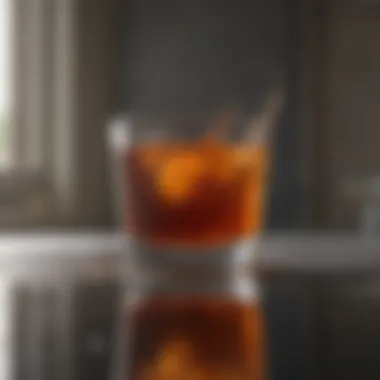

Drying Imperfections
Drying imperfections can manifest in various forms—a tacky surface, drip marks, or cloudiness. These imperfections can result from applying the polycrylic in unfavorable conditions or neglecting necessary drying times between coats. One common pitfall happens when applying a second layer of polycrylic too soon, trapping some moisture from the first coat.
To dodge this bullet, always factor in the drying times recommended on the label, which usually indicates between one to two hours. If you notice that a project is tacky after a full day, it may require simply more time in a dry, ventilated area. In unfortunate cases of larger imperfections, a light sanding followed by reapplication can be the remedy to revive your project’s beauty.
In summary, understanding these common issues—bubbles in the finish, uneven coating, and drying imperfections—can significantly affect the quality of your projects using water based polycrylic spray. By applying the proper techniques and patiently troubleshooting, you can ensure a polished, professional look that enhances the beauty of your efforts.
Maintenance and Longevity
When it comes to achieving enduring beauty in projects involving water based polycrylic spray, maintenance and longevity play a vital role. This not only ensures that surfaces maintain their aesthetic appeal, but also enhances the life of the finish. Regular upkeep prevents degradation over time, which could otherwise compromise both the look and the protective qualities of your work.
Cleaning Techniques
Keeping surfaces clean is essential to preserving the charm of your projects. When it comes to cleaning, a gentle touch is preferred. Here are a few guidelines to follow:
- Use a soft cloth or sponge: Avoid abrasive materials, as they can scratch the surface. Instead, opt for microfiber cloths or damp sponges.
- Mild soap solution: Mix warm water with a few drops of a mild soap. This solution is effective without causing harm. Gently wipe the surface without soaking it, ensuring that no cleanser remains.
- Quick response: It’s best to address spills or stains immediately. The longer a stain sits, the harder it may become to clean up.
- Avoid harsh chemicals: Strong cleaners can break down the finish. It's crucial to stay away from products containing ammonia or bleach.
After cleaning, allow the surface to dry completely before applying any new coats or protection. Keeping an eye on how your surfaces are faring over time can help you catch potential issues early.
Reapplication Guidelines
Even the best finishes require touch-ups or reapplication from time to time. Knowing when and how to do this can save you a lot of hassle. Here are some pointers to keep your items looking fresh:
- Assess wear and tear: Regularly evaluate the surface. If it appears dull or is starting to show signs of wear, it's likely time for a new coat.
- Light sanding: Before applying another layer, lightly sand the surface with fine-grit sandpaper. This step promotes adhesion and leads to a smoother finish.
- Clean before reapplication: Ensure the surface is clean and dry before proceeding. Any dust or oil can compromise the integrity of the new coat.
- Follow application instructions: Consistency is key. Adhere to the same methods you utilized for the initial application for best results.
- Timing matters: Waiting for the recommended drying time between layers is crucial. This can vary based on humidity and temperature, so it's worth checking labels carefully.
"Regular maintenance can not only elevate the aesthetic value of your projects but also improve their durability."
By staying vigilant with cleaning and adhering to reapplication guidelines, you can ensure your water based polycrylic projects remain vibrant and intact for years to come.
Comparison with Other Finishes
When considering finishes for your woodworking or crafting projects, it’s crucial to understand the distinct characteristics and applications of various options. Comparing water-based polycrylic spray with other finishes, such as oil-based varieties and water-based varnishes, helps in making informed decisions based on your needs. Each type of finish has its own set of advantages and disadvantages that come into play depending on factors like the type of surface, desired effect, and working conditions.
Oil Based Varieties
Oil-based finishes are renowned for their exception durability and rich finishing touch. They penetrate deeply into the wood, providing a robust protective layer that can stand the test of time. This kind of finish tends to enhance the natural grain of the wood, giving it a vibrant and warm appearance. Here are some key considerations for oil-based finishes:
- Durability: They generally offer superior resistance to scratches and wear but take significantly longer to dry.
- Yellowing: Over time, oil-based finishes can yellow, which might affect lighter woods or light-colored projects.
- Application: Applying these finishes often requires more prepping work, including proper thinning and extensive cleaning, as they are not as user-friendly as their water-based counterparts.
- Odor: The fumes can be a deterrent, especially in enclosed spaces, due to the strong solvents involved.
In short, while oil-based finishes provide a lovely depth of color and durability, the trade-offs in application processes and potential yellowing make them less appealing for some. This is especially true for house owners and homemakers who prefer a simpler approach with less fuss.
Water Based Varnishes
Water-based varnishes are gaining popularity for their low environmental impact and ease of use. They dry quickly, have minimal odor, and clean up easily with water. They’ve come a long way and can rival oil-based finishes in terms of durability and appearance. Important points about water-based varnishes include:
- Clear Finish: Unlike oil-based finishes, water-based varnishes usually remain clear over time, making them suitable for maintaining the natural look of the wood.
- Quick Drying: You can apply multiple coats in one day, significantly speeding up your project timeline.
- Low VOCs: With a lower level of volatile organic compounds, they are safer for indoor use, especially in homes with children or pets.
- Less Penetrative: They sit on top of the wood rather than penetrating, which may require additional surface preparation for optimal bonding.
Ultimately, water-based varnishes are ideal for projects where cleanliness, speed, and low odor are paramount.
"Water-based options allow for quick turnarounds without sacrificing quality."
Ending
The conclusion serves as a pivotal element in this article, tying together the various threads explored throughout the guide regarding water based polycrylic spray. It underscores not only the versatility of this product but also the practical considerations that homeowners and crafting enthusiasts must keep in mind.
In today's eco-conscious world, opting for water based polycrylic spray stands out as a sensible choice. This finish combines efficiency with environmental responsibility, catering perfectly to both aesthetic and functional needs. Whether you are finishing a furniture piece or sprucing up a craft project, understanding the key components of this product helps you make informed decisions.
Summary of Key Points
- Versatile and Convenient: Water based polycrylic spray can effectively be used on a multitude of surfaces, from wood to canvases, making it suitable for a wide array of projects.
- Rapid Drying: Unlike oil-based finishes, water based options dry quickly, allowing you to move on to the next steps in your project without long waiting times.
- User-Friendly Application: With proper techniques like maintaining distance and layering, anyone from seasoned builders to novice crafters can achieve a professional-looking finish.
- Environmental Benefits: With lower VOCs, this finishing spray is kinder to our planet, aligning better with sustainable living practices.
- Common Pitfalls: Awareness of potential issues, such as bubbles or uneven coatings, puts you one step ahead in ensuring a flawless result.
Final Thoughts
The exploration of water based polycrylic spray not only opens up a realm of possibilities for creative expression but also empowers homeowners to take control of their projects. Its qualities make it a reliable choice for both aesthetic enhancement and lasting protection.
In light of the multitude of benefits discussed, it’s clear that this finish is a game-changer for anyone who values efficiency and quality. A final piece of advice: don’t hesitate to experiment, and remember that each brushstroke or spray is an opportunity to learn. So, arm yourself with knowledge, gather your supplies, and embark on your next home-improvement journey with confidence. After all, a beautifully finished project is just a spray away!
"Good preparation and understanding leads to good results in every project!"



